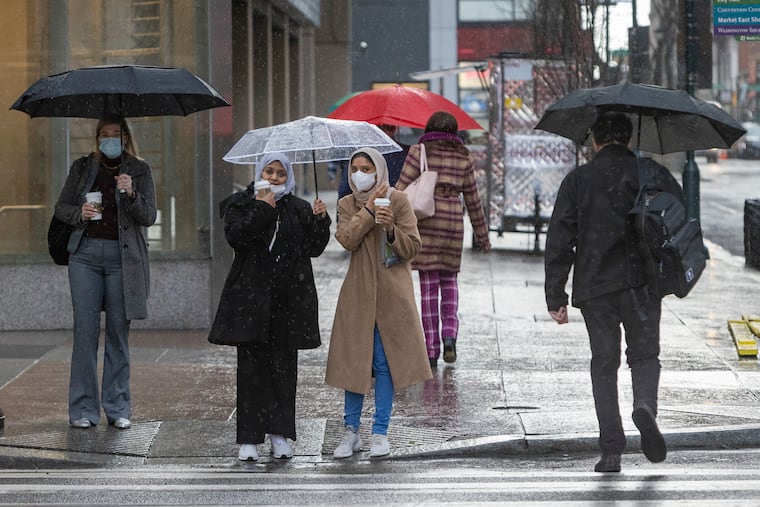Let’s approach COVID like the weather. Depending on conditions, we grab an umbrella (or mask).
We use weather forecasts to adjust our behavior (grab an umbrella) and know when we need to help dig out a neighbor's driveway. We can use that same framework to keep people safe from COVID-19.

I am one of those rare individuals who has not gotten COVID-19, probably because of the restrictive way I have lived since February 2020. At the start of the pandemic, my doctor told me that I was at high risk for complications because I have myalgic encephalomyelitis (sometimes called ME/CFS or chronic fatigue syndrome) — a debilitating neuroimmune disease. Even though I am vaccinated against COVID, a mild case could permanently worsen my disability, so I am highly motivated to avoid infection.
Yet my ability to protect myself and enjoy my life has become more difficult, and the latest Centers for Disease Control and Prevention guidelines will make it even harder. The new CDC guidelines released this month do even more to shift the responsibility for limiting spread of COVID from institutions and businesses to individuals. Asymptomatic people do not need to get tested, nor are they required to quarantine after a known exposure. Gone is social distancing, or the “six-foot” rule that encouraged people to keep their distance to avoid infection. People act like COVID isn’t here anymore.
» READ MORE: I have a chronic illness. During COVID, isn’t my life worth protecting? | Opinion
Of course, people like me who are at high risk of severe disease can still wear masks in public, but with these new changes from the CDC, we are now more likely to encounter contagious people in the community. So are our family members and caregivers.
The number of high-risk people is larger than you might think. According to an estimate by the Kaiser Family Foundation, one in four adults is at risk of serious illness if they become infected because they are over 65 or have a chronic illness like mine. Even people who aren’t high risk should be concerned about long COVID, which becomes more likely with each additional infection.
For their sake, I believe there is a safer — and smarter — way to move forward collectively.
“I believe there is a safer — and smarter — way to move forward collectively.”
We have experience balancing individual and collective responsibilities to cope with other natural threats, like the weather. So why not apply what works there to COVID?
Weather forecasts give us daily information we need to go about our lives. We adjust our behavior by taking an umbrella when it might rain or stocking up on groceries when a winter storm is on the way. We also receive warnings about weather-related dangers like tropical storms, drought, or high winds.
With this information, we know when others in our communities may need help, like checking on vulnerable neighbors in extreme temperatures or shoveling each other’s cars out of the snow. Yet we need government and institutions to help us cope with conditions as well. Our local governments remove snow in winter and provide cooling stations in summer, and the federal government provides resources to help with natural disasters.
We also accept restrictions on our behavior for the benefit of the community. My township requires me to clear my sidewalk within 24 hours of a snowstorm, whether I plan to walk down the street or not. We expect people to restrict their water usage in a drought or lower their electricity consumption in a heat wave. Everyone accepts the necessity of closing roads and schools during snowstorms or floods. We can’t change daily weather conditions, but we cooperate to mitigate the impact, especially on the most vulnerable.
How could we apply this framework to COVID? The government should provide us with information about COVID conditions, including infection trends, new variants, and health-care capacity — a much more detailed COVID forecast than what’s provided by the current community levels map. When the variables added to the COVID model point in the wrong direction, we should mask indoors, especially in settings like public transportation. We’d rely on the government and institutions to help out, such as by protecting people’s jobs if they have to stay home because of symptoms, and providing COVID funding packages to communities, similar to what they get after hurricanes and other natural disasters.
The new CDC guidelines don’t help us look out for each other, and that raises everyone’s risk in the long run. An individual decision not to mask is not the same as leaving your umbrella at home. It makes no difference to me if you decide to get wet, but I care very much if you are contagious and walking around the community.
COVID is here to stay, and it will wax and wane like storms and drought. And just like the weather, we must cope with it individually, with personal protective measures, and collectively, through actions that protect our communities. This would give all of us a chance to enjoy our lives while staying as safe as possible.
Jennie Spotila is a writer who lives in King of Prussia. She writes about ME/CFS at occupyme.net.